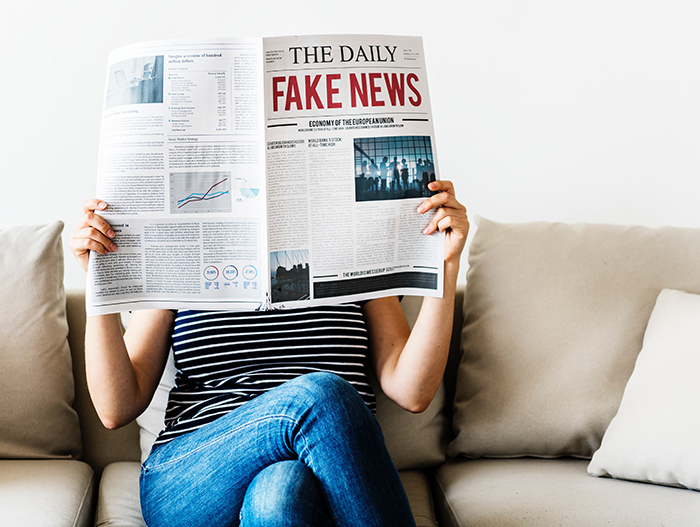Professor outlines history of media falsehoods, defines 'fake news'

LAWRENCE — The term "fake news" has been used a great deal since the 2016 presidential election. But many might not realize media hoaxes and fakery have existed since the beginning of mass media in the United States. A University of Kansas professor has authored a new study outlining the history of falsehoods in media, how they have evolved and the danger of current fake news to help provide a better understanding of the phenomenon.
 Benjamin Franklin, Edgar Allan Poe and Mark Twain are among America’s most beloved writers and public figures. And they all have a history of using the media for hoaxes. Teri Finneman, assistant professor of journalism, has co-authored an academic article using examples of the three revered figures and others using the media to publish fantastical stories. After the works — one about bison living on the moon — caused a sensation, the authors revealed they were not real to educate people on how gullible they could be and how dangerous it was to believe the pseudoscience of the day.
Benjamin Franklin, Edgar Allan Poe and Mark Twain are among America’s most beloved writers and public figures. And they all have a history of using the media for hoaxes. Teri Finneman, assistant professor of journalism, has co-authored an academic article using examples of the three revered figures and others using the media to publish fantastical stories. After the works — one about bison living on the moon — caused a sensation, the authors revealed they were not real to educate people on how gullible they could be and how dangerous it was to believe the pseudoscience of the day.
“People think fake news is so new, but really it’s not,” Finneman said. “The first newspaper in America was founded in 1690, and you can trace fake news and hoaxing back to the beginning of media in this country. However, there wasn’t this long-term duplicity going on in those cases. The difference was they came out and said, ‘This was fake. Why did you believe it?’”
Finneman co-authored the article, published in Newspaper Research Journal, with Ryan Thomas of the University of Missouri.
Finneman, who studies journalism history, and her co-author trace the evolution of hoaxing and fake news from its early days into the yellow journalism era of the late 19th century. They point out that around the early 20th century, mass media looked down on the practice of sensationalism and using media to push false or misleading information. The practice largely disappeared except for instances of April Fools' Day issues, especially popular in student media, which are commonly justified as being humorous and without the explicit intent of misleading people.
The history of falsehoods in the media took a giant leap with the advent of social media, especially in the lead-up to the 2016 elections. Nefarious actors took the steps of mimicking mainstream media, producing content that looked genuine with the intent of misleading people and sowing discord in the populace. In the early 2010s, social media was not a major part of everyday life for a large majority of Americans. By the elections, social media’s popularity had skyrocketed and proved to be a fertile ground for false information masquerading as legitimate news.
“That’s what greatly complicated fake news. Now everybody has access, and media is much more complex,” Finneman said. “We are being bombarded by information everywhere, and it’s a lot more work to decipher information coming in and if it’s legitimate.”
The authors argue it is vital to define what fake news is and what it is not:
- Unlike the media hoaxes of the past, fake news has the intent of avoiding detection as untrue.
- It is content specifically designed to fool people by appearing to be from reputable sources.
- Most importantly, fake news should not be defined in its current popular form, which is accusing reputable news sources of being “fake news” for not publishing information that doesn’t agree with certain opinions or viewpoints.
With a clear definition and understanding of what fake news is, researchers can better understand it, educators can better inform people of what news is legitimate and what is not, and media can do a better job of helping the public understand the work they do and why it is trustworthy.
A lack of media literacy in the populace has helped fake news flourish. To that end, Finneman and colleagues have held fake news panels to help the public better determine if news is legitimate and to understand how real media gather their facts, report news and deliver their news product. Media waited too long to push back against accusations of being fake and now are playing catch up on setting the record straight about how they gather and report factual information, Finneman said. Scholars can help in those efforts by giving clarity to what the phenomenon is.
“The goal of the paper is to reclaim what fake news is. Fake news is what happened with Russian and outside actors actively putting out false information and purposefully trying to deceive,” Finneman said.
As a journalism historian, Finneman said history can provide insight into how the industry has evolved and confronted challenges in the past. In addition to her teaching and research, she hosts the podcast "Journalism History." With a new episode every two weeks, it’s “a podcast that rips out the pages of your history books to re-examine the stories you thought you knew and the ones you were never told.” As vice chair of the Association for Education in Journalism and Mass Communication history division, Finneman said she hopes the podcast is both entertaining and useful to educators. It is available on iTunes, Spotify, the Apple Podcast App and at journalismhistorypodcast.podbean.com.